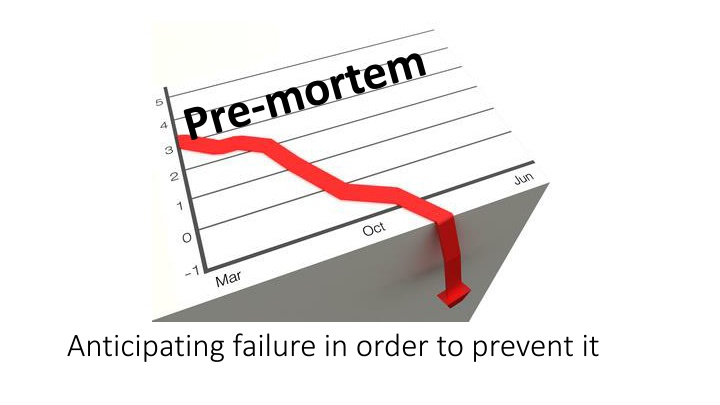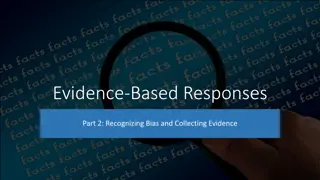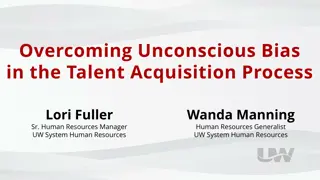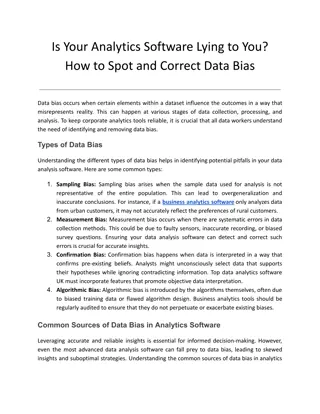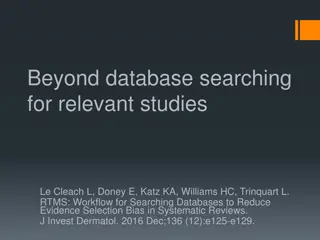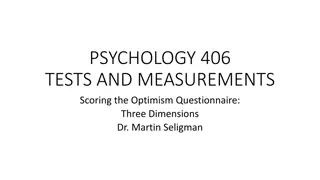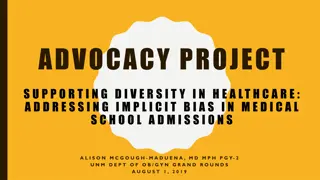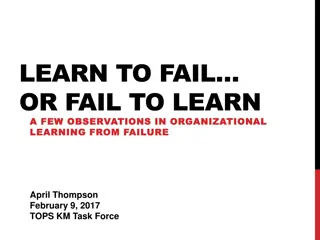Preventing Failure: Understanding the Optimism Bias
Anticipating failure is crucial to preventing it. Explore the optimism bias and the importance of self-criticism in predicting the future. Learn from Sun Tzu and Gary Klein's insights on preparing for success. Discover the Pre-mortem Process for analyzing project failures. Dive into the case study of Happy Pizza to understand the risks of expanding a business without thorough research.
Uploaded on Feb 23, 2025 | 0 Views
Download Presentation

Please find below an Image/Link to download the presentation.
The content on the website is provided AS IS for your information and personal use only. It may not be sold, licensed, or shared on other websites without obtaining consent from the author.If you encounter any issues during the download, it is possible that the publisher has removed the file from their server.
You are allowed to download the files provided on this website for personal or commercial use, subject to the condition that they are used lawfully. All files are the property of their respective owners.
The content on the website is provided AS IS for your information and personal use only. It may not be sold, licensed, or shared on other websites without obtaining consent from the author.
E N D
Presentation Transcript
The Optimism Bias The Optimism Bias 80% of people over-estimate the amount of good that will happen to them and under-estimate the amount of bad things that will happen to them.
Fact 1 : Human beings love to predict the Fact 1 : Human beings love to predict the future. future. Fact 2: Human beings are not very good at Fact 2: Human beings are not very good at predicting the future. predicting the future. Reason for bad prediction Dogmatism (the tendency to lay down principles as undeniably true, without consideration of evidence or the opinions of others). Reason for good predictions Capacity for self-criticism and willingness to ask What would it take to convince me that I m wrong
Every battle is won before it s ever fought Sun Tzu
Gary Klein prospective hindsight imagining that an event has already occurred... increases the ability to correctly identify reasons for future outcomes by 30%.
The Pre The Pre- -mortem Process mortem Process 1. Read any BUSS1,2 or 3 case study, or discuss any upcoming project. 2. As a group, we imagine that the business/start-up/project has failed disastrously. 3. Individually, we list all of the reasons for this disastrous failure (5 minutes) 4. As a group we share and then rank our various reasons. 5. As a group, we suggest solutions, preventative measures and alternatives
1. Happy Pizza 1. Happy Pizza Big Dom had built up a loyal customer base with his mobile pizza business. In his trusty PizzaMobile, he cooked pizzas from a small kitchen and delivered to customers homes and businesses to keep his (and their) costs low. He decides to apply for a Happy Pizza franchise. The brand is recognised and respected by over 70% of adults in the UK. Dom estimates that his sales would increase after the first year and he would be able to get additional revenue from drink and dessert sales He found a nice location with low rent near his house in Birmingham, but Happy Pizza insist on city centre locations, despite the presence of chain pizzerias and rent being 50% higher. Dom didn t spend much on market research so his cost estimates were from Happy Pizza, and he based his revenue predictions on 2 Happy Pizzas restaurants in London. Dom predicted customer spend of 15 and variable costs of 5. Based on info from Happy Pizza and a small random sample of locals, he predicted 7700 customers per year. He spent lots of time on his cash flow forecast, and this revealed huge cash deficits in his first year. This was due to high start-up costs and so he decided to rent instead of buy. He also needed a loan. His main concerns were yearly fixed costs of 63000 and Happy Pizza s market share starting to decline after 15 years of growth.
2. Look into the future and imagine that the business has failed disastrously. What are the reasons for this?
3. Not-so-Happy Pizza. On the cards provided, list all of the reasons why it may fail. Marketing Reason: Finance Reason: Human Resources Reason: Operations Reason:
4. Do your reasons match with Mr (who ever is delivering the lesson)s? 1 mark for 4. Do your reasons match with Mr (who ever is delivering the lesson) s? 1 mark for each each Which are the most important from each functional area? Which are the most important from each functional area? Marketing Loyal customer didn t frequent the city centre restaurant? Little market research Respected by 70% of adults according to who? Happy Pizza market share continued to decline Strong competition from big chains Due to decline market share, less demand for Dom s restaurant Finance Lots of estimates Why does he estimate that revenue will increase? High rents Revenue estimates based on London restaurants Break even of 6300 customers, prediction too optimistic Cash deficit Interest rates on loans Operations Quality of staff and food may not have been up to standard Over predicted demand therefore low capacity utilisation Customers not happy with the service and switch to competitors Human Resources There is no mentioned of Dom ever having employed or managed anyone before Dom doesn t seem to have budgeted for training costs
5. For each potential reason for failure, suggest a solution, preventative measure or alternative. Marketing Solution: Finance Solution: Human Resources Solution: Operations Solution:
What are the priorities for Dom? What should he do first and why?
